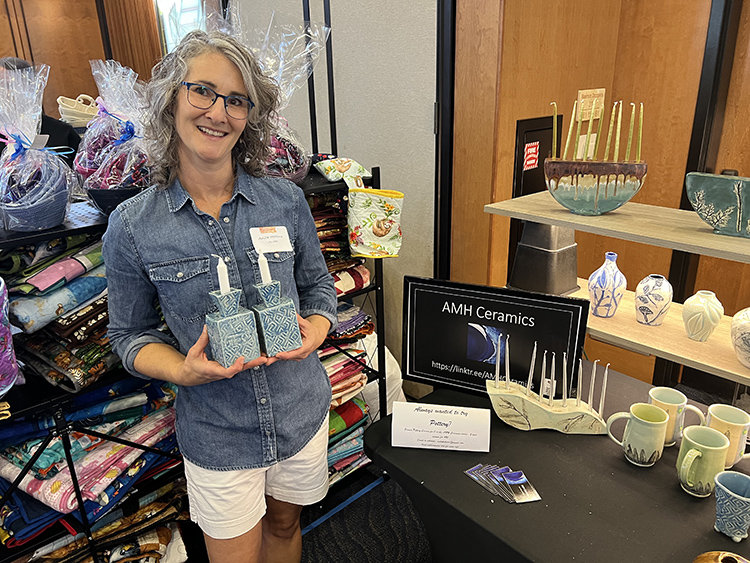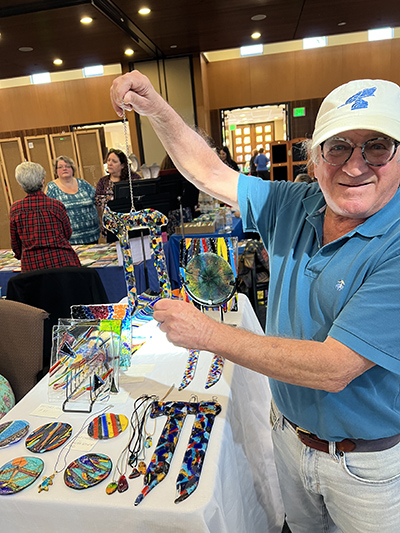
By Donald H. Harrison


SAN DIEGO – In 1973, the philosopher Jacob Bronowski (1909-1974) narrated “The Ascent of Man,” a 13-part series on the Public Broadcasting System (PBS). At the time, he was a fellow of the Salk Institute for Biological Studies in La Jolla and had a big influence on the thinking of biologist Jonas Salk (1914-1995).
In particular, Salk often quoted Bronowski’s speculation that science and the arts, rather than being absolutely distinct disciplines, can be interactive. Salk liked to quote Bronowski’s theory that astronomer Nicolas Copernicus (1473-1543) developed his heliocentric concept of the universe while contemplating the famous “Vitruvian man” drawing by Leonardo da Vinci. (1452-1519).
It was coincidence that two artisans who exhibited their work at Temple Emanu-El’s artisans festival on Sunday, Nov. 5, both had scientific backgrounds. Jonathan Rosenberg had worked prior to retirement as an immunologist at PharMingen and at Becton, Dickinson (BD) during 16 years of his career. Anita Hettena was a biology professor, specializing in the teaching of anatomy, at San Diego City College.
Asked if there was some nexus between the sciences and the arts, Hettena responded, “What I love about ceramics is that there are tons of experimentation, so you come up with an idea — ‘I wonder what this will look like if I do this’ – and then you do the experiment, you get the results, and from the results you move on. So, there are parallels.”
Rosenberg said that as an immunologist, “I was into separating cells on the basis of what was on their surface – leukemia, lymphoma, immune responses – by fluorescent color tags, so I always have been aware of the color spectrum. I would sort them and analyze them through a cell sorter.”
“For me,” Rosenberg added, “it is a joy to still be creative and give back beauty to people.”
Among Hettena’s ceramics and Rosenberg’s fused glass creations are pieces reflecting a variety of themes. I found myself most drawn to the Judaica that each of them had created.
Hettena, who works from a home studio with two potter’s wheels and a kiln in the Mt. Helix area of La Mesa, likes to incorporate plants in her work. “Real leaf impressions are in a lot of my work,” said the former biology professor. In another technique, she carves through a colored strip to the clay underneath.
Currently, Hettena is creating a lot of Judaica because Chanukah is fast approaching. Although not Jewish herself, her husband is and their two sons, 18 and 13, have been raised in the Reform movement. In fact, the 13-year-old just celebrated his bar mitzvah at Temple Emanu-El, where the family has a membership.
Considering converting, Hettena says she has Jewish yichus (genealogy). She is directly descended from Isaac Harby (1788-1828), a Sephardic Jew who insisted that Hebrew prayers be repeated in English and that rabbis sermonize in English about the Torah portion of the week. Harby, who lived and taught in Charleston, South Carolina, is widely considered to have been one of the early influences leading to the development of Reform Judaism.
Rosenberg comes from the other end of the Jewish religious spectrum. He worships and regularly attends morning minyan at the Beit Betzalel Chabad of North County Inland, led by Rabbi Yehuda Trestman, who is also a medical doctor.
Among Rosenberg’s creations on display at Temple Emanu-El’s festival were bright, multi-colored chai’s, which, he joked, that visitors will occasionally mistake for a “long-legged moose.” He also has hannukiahs with “unbridled color” and similarly striking mezuzot.
“I don’t put a scroll in them because it’s not kosher unless it’s by a sofer and on a special paper – papyrus,” he commented. “I have a sensitivity of that.”
Rosenthal took up fused glass work while he was still working as an immunologist, whereas Hettena didn’t find her passion for ceramics until a couple of years after she left teaching to spend more time with her children.
After she quit her job, “I knew I wanted to do something else, but I didn’t know what it was,” she related. “So, I had a couple of years when I was volunteering, trying different things. I got frustrated with that. I thought I needed a hobby, so I joined a pottery class (in the La Mesa area) and then I couldn’t stop.”
Rosenberg said he learned about fused glass from the folks at Blue Dolphin Art Glass on Mission Gorge Road, where he buys glass to take home to work on, and then returns to use their kiln.
“The fun part is to be able to continue to express myself,” Rosenberg says. His works are exhibited at the Off Track Gallery in Encinitas, and at the COAL (Carlsbad-Oceanside Art League) gallery in Carlsbad.
Examples of Hettena’s work may be found on her website.
*
Donald H. Harrison is editor emeritus of San Diego Jewish World. He may be contacted via donald.harrison@sdjewishworld.com